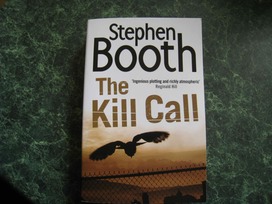Thursday, 27 January 2011

If there's an official checklist of things to do when you're embarking on a crime fiction series the first two items on the list probably involve finding an appropriate setting and a couple of characters whose interactions can give the author a constant subplot to work the investigations around.
As far as settings go, Stephen Booth has struck gold in Derbyshire's Peaks District, a jumble of villages and moorland with enough lanes, walking tracks, disused mine shafts and other under and above ground features to allow a plethora of ways in and out of crime scenes,means to dispose of bodies and so on.
On top of that, in a rural area close to major cities a constant stream of day-trippers and other passers-by provides plenty of potential suspects, victims and red herrings, and a mixture of well-heeled landed folk, wealthy refugees from the urban sprawl and secretive, cloistered villagers who more than likely have something to hide means that you’ve got plenty of potential on the ground regardless of blow-ins from outside.
Booth hasn't done too badly with his core characters either. Start with edgy city girl with nasty things in her past Diane Fry, who’s landed the Sergeant’s position local boy son of much-loved copper Ben Cooper was aspiring to, and throw in if it moves I can probably eat it bloke Gavin Murfin who mightn't add much to the investigative action but serves as a constant source of irritation for Fry as he does a lot of the foot-slogging associated with an investigation and you’ve got plenty to work with.
By the ninth story in a series you'd expect those elements to be more or less down pat, and might suspect the author's going to have difficulty adding new elements to the mix, but Booth manages it well, intertwining contemporary issues about fox hunting (plenty of room for conflict and potential suspects and motives there) and recent historical factors most of the population have conveniently forgotten about.
The discovery of the body of a man whose head has been crushed in one spot along with an anonymous call reporting the same body half a mile away is enough to get things off to a racing start, particularly when you've got a nearby gathering of the local hunt and horseshoe tracks all around the corpse.
As is the way of these things there are a couple of issues that muddy the waters. For a start there's an enigmatic diary that must have something to do with things, but it's not clear what that something is (at least, not at first) and a youthful loner who makes off with the dead man's wallet and mobile phone, but has nothing to do with the presumed murder.
The most obvious motive lies in the confrontational and occasionally violent world of hunting and hunt protesting saboteurs, and investigations reveal that the dead man is involved in shady dealings that probably involve horse theft and the meat trade. It would help greatly of Fry and Cooper were able to track down the dead man's accountant, but he seems to have gone to ground, and in the end, that's the way it turns out to be.
So, as the investigation meanders down a complex trail we have the odd entanglement creeping in there as well. Cooper's cat dies and needs to be replaced, and he's growing increasingly distant from the surviving members of his family. Diane Fry continues to have trouble with her past, which refuses to quietly recede into the background, and we get an introduction to the 'plague village' of Eyam (pronounced 'Eem', just to provide another means to underline the Diane Fry doesn't fit in with the local yokels theme) which is a contemporary tourist attraction.
Then there's the secondary theme that shows the oft-remembered sixties through a different perspective, a time as much about the threat of nuclear warfare and four-minute warnings as it was about Swinging London, Carnaby Street, peace, love and understanding.
As a series, this doesn't quite rate up there with my favourites, but it's good enough to warrant a check through the 'B' shelves at the local library and is something to watch for when scouring the el cheapo display at the local newsagent.
Not, in other words, the greatest thing since sliced bread, but a definite cut above a lot that's out there.